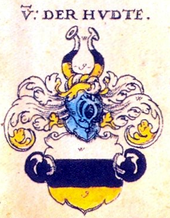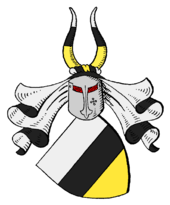Hude (noble family)
Hude or von der Hude is the name of an old noble family originally from Bremen . The family was able to spread to Holstein , Lauenburg and Mecklenburg early on , and individual branches still exist today.
history
The von der Hude were agnatically related to the von Bremen , which were important personalities in the Archdiocese of Bremen .

With Ritter Lüder de Hude , the oldest representative of the family appears in the years 1181 to 1191, who bears the name Hude after the ancestral estate Ritterhude . The Burg Huda served 1309 according to the Bremer Urkundenbuch, to guard the ford on the Hammering as the only Heerwegs of Hamburg according Bremen . In 1380 the knights and squires of the Hude vowed that “ounce slot” should be an open house, thus avoiding the razing of the castle. In 1757 the castle and dam bridge were destroyed in the Seven Years War , but the moated castle was then rebuilt as a mansion. In 1774, Friedrich August von der Hude, the last member of his family, died at Ritterhude Castle. The dam was then acquired by Georg von Gröning , who later became mayor of Bremen (since 1919 owned by those of Rex- Gröning ). Two of the three courts in St. Jürgensland and Trupe , namely Niederende and Oberende, were owned by the von der Hude family in the 15th century, while the third belonged to the Lilienthal monastery .
A branch from the von der Hude ministerial family provided several councilors , with Detward von der Hude († 1430) also a mayor in Bremen. Later the family u. a. also spread to Lübeck . Three generations with the name Bernhard H (e) inrich von der Hude were senior pastors at the Marienkirche in Lübeck . The sons of the youngest (1768–1828), Heinrich von der Hude (1798–1853) and Hermann von der Hude (1811–1858), became senators of the Hanseatic city of Lübeck.
Knight Martin von der Hude was the first of his line to appear from 1326 as Mecklenburg bailiff . The brothers Heinrich and Arnold von der Hude and their cousin Johann von der Hude sold their Mecklenburg goods Kulitz and Nedum to the Eldena monastery . In 1363 Heinrich von der Hude was the last member of the family in Mecklenburg.
coat of arms
Bremen

Coat of arms 1 (in use until 1320): In the (presumably silver) shield four eagle claws (presumably black, red-armored) opposite one another (presumably black and red). Coat of arms 2: In the shield a helmet with two raised eagle claws as a crest ornament. Coat of arms 3 (in use from 1320): Shield divided into three transverse bars: silver, black and gold.
Mecklenburg
The shield with crossbar; on the helmet three spikes with cock feathers, the middle one vertical, the other two horizontal. Later the shield was striated from silver to green; two buffalo horns on the helmet.
Relatives (chronological)
- Bernhard von der Hude, banished from Bremen in 1304 in the course of the council feud of 1304/1305
- Detward von der Hude († 1430), Mayor of Bremen
- Hinrich von der Hude († 1459), wholesale merchant, councilor in Bremen
- Eilard von der Hude (1541–1606), German chronicler
- Bernhard Heinrich von der Hude (clergyman, 1681) (1681–1750), senior pastor at St. Marien zu Lübeck
- Jürgen Matthias von der Hude († 1751), German painter
- Bernhard Heinrich von der Hude (1731–1795), senior pastor at St. Marien zu Lübeck
- Bernhard Heinrich von der Hude (1765–1828), senior pastor at St. Marien zu Lübeck
- Heinrich von der Hude (1798–1853), Syndicus and Senator of the Hanseatic City of Lübeck
- Hermann von der Hude (1811–1858), Senator of the Hanseatic City of Lübeck
- Hermann von der Hude (1830–1908), German architect
literature
- Wolfgang Cheap: Georg Ulrich von der Hude. From 1666 to 1699 pastor in Breselenz. In: North German Family Studies 37 . 1988, pp. 346-352.
- Wolfgang Cheap: On the genealogy of those von der Hude in the former diocese and principality of Verden. In: North German Family Studies 38 . 1989, pp. 617-638.
- Wolfgang Billig: On the life story of Georg Friedrich von der Hude from 1712 to 1738 pastor to Satemin and Wustrow. In: North German Family Studies 36 . 1987, pp. 161-172.
- Erwin Freytag: To the older genealogy of the gentlemen von der Hude. In: Zeitschrift für Niedersächsische Familienkunde 45, 1970, pp. 46–49, and 167.
- Franz Wilhelm von der Hude: The enfeoffment of the von der Hude family by the Counts of Oldenburg or "the drama of an Erbmannlehens". In: North German family studies 29 . 1980, pp. 75-78.
- Ernst Heinrich Kneschke : New general German nobility lexicon . Leipzig 1863, Volume 4, p 507. .
- Luneburg Mushard : Monumenta nobilitatis antiquae familiarum illustrium, in ducatibus Bremensi & Verdensi, i. e. Meal of the clock-old, noble families, in particular the highly commendable knights in the Hertzogthum Bremen a. Verden. Herman and Berthold Brauer, Bremen 1708, p. 295.
- Hans G. Trüper : The Bremen councilor family von der Hude, a branch of the ministerial family of the same name. In: North German family studies 25 . 1976, pp. 405-413; 27, 1978, pp. 261-262 (Notes).
- Hans G. Trüper: The genealogy of the pin Bremen ministerial family from the Hude to the middle of the 15th century. In: North German family studies 34 . 1985, pp. 347-369, 401-446; 35, 1986, p. 483 (corrections).
- Hans G. Trüper: Johann von der Hude, d. 1530/44. In: The graves in the St. Petri Cathedral in Bremen 9 . 1999, pp. 38-39.
- Hans G. Trüper: Segebade von der Hude (around 1500–1578). In: The graves in the St. Petri Cathedral in Bremen 2 . 1996, pp. 41-47.
- Wolfgang Ollrog: Back to Hinrichs - von der Hude - Wiarda / Zerneman. A final word. In: North German family studies 27 . 1978, pp. 261-262.
- Isa Ramm: The descent of East Frisian families from the von der Hude family in Bremen. In: Sources and research on East Frisian family history and heraldry 26 . 1977, pp. 111-115; 27, 1978, pp. 19-20, 20-23, 86-88.
Web links
- Hude, from the. In: Johann Heinrich Zedler : Large complete universal lexicon of all sciences and arts . Volume 13, Leipzig 1735, column 1060 (family article).
- The Von der Hude Family
Individual evidence
- ↑ a b c George Adalbert von Mülverstedt (Hrsgb.): Siebmacher's great book of arms. New sieve maker. Extinct Mecklenburg nobility . Nuremberg 1902, p. 51, plate 27.
- ↑ Hans G. Trüper : Knights and Knappen between Weser and Elbe, Die Ministerialität des Erzstifts Bremen. Stade 2000, ISBN 3-931879-05-4 , p. 252, plate 16.
- ↑ Adolf E. Hofmeister: Dutch settlements on Weser and Elbe 1113-2013 - 900 years Bremer Hollerland , in: Bremisches Jahrbuch 92 (2013) 19-46, here: p. 34 ( digitized version ).
- ^ Emil Ferdinand Fehling : On the Lübeck Council Line 1814-1914. Max Schmidt, Lübeck 1915, Nos. 51 and 56. Commons digitized .
- ↑ Hans G. Trüper: Knights and Knappen between Weser and Elbe. The ministry of the Archbishopric of Bremen. Stade 2000, ISBN 3-931879-05-4 , pp. 935 and 997.
- ↑ Hans G. Trüper: Knights and Knappen between Weser and Elbe. The ministry of the Archbishopric of Bremen. Stade 2000, ISBN 3-931879-05-4 , p. 541.
- ↑ Epitaph in BuK, p. 379
- ↑ Epitaph in BuK, p. 381
